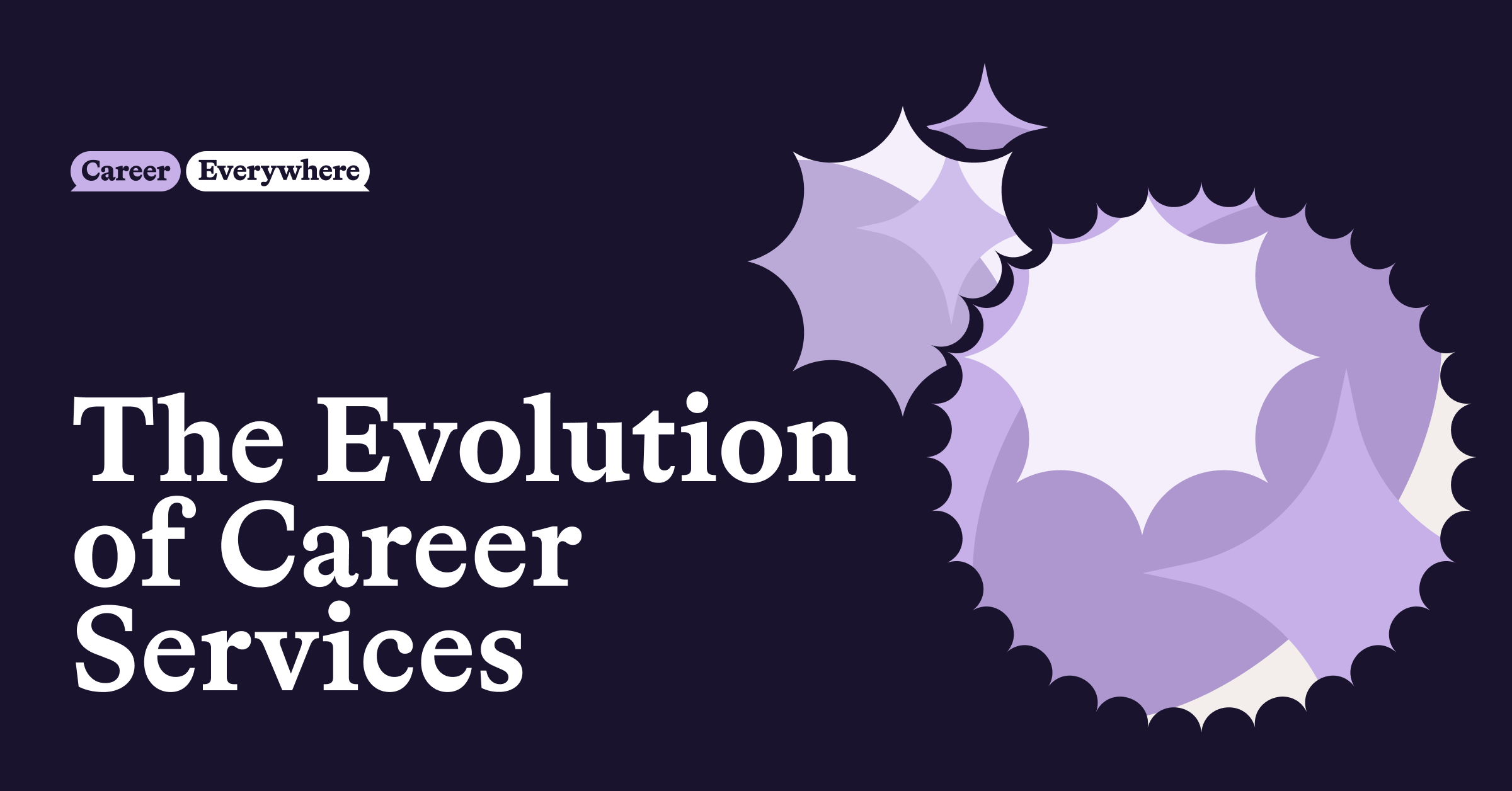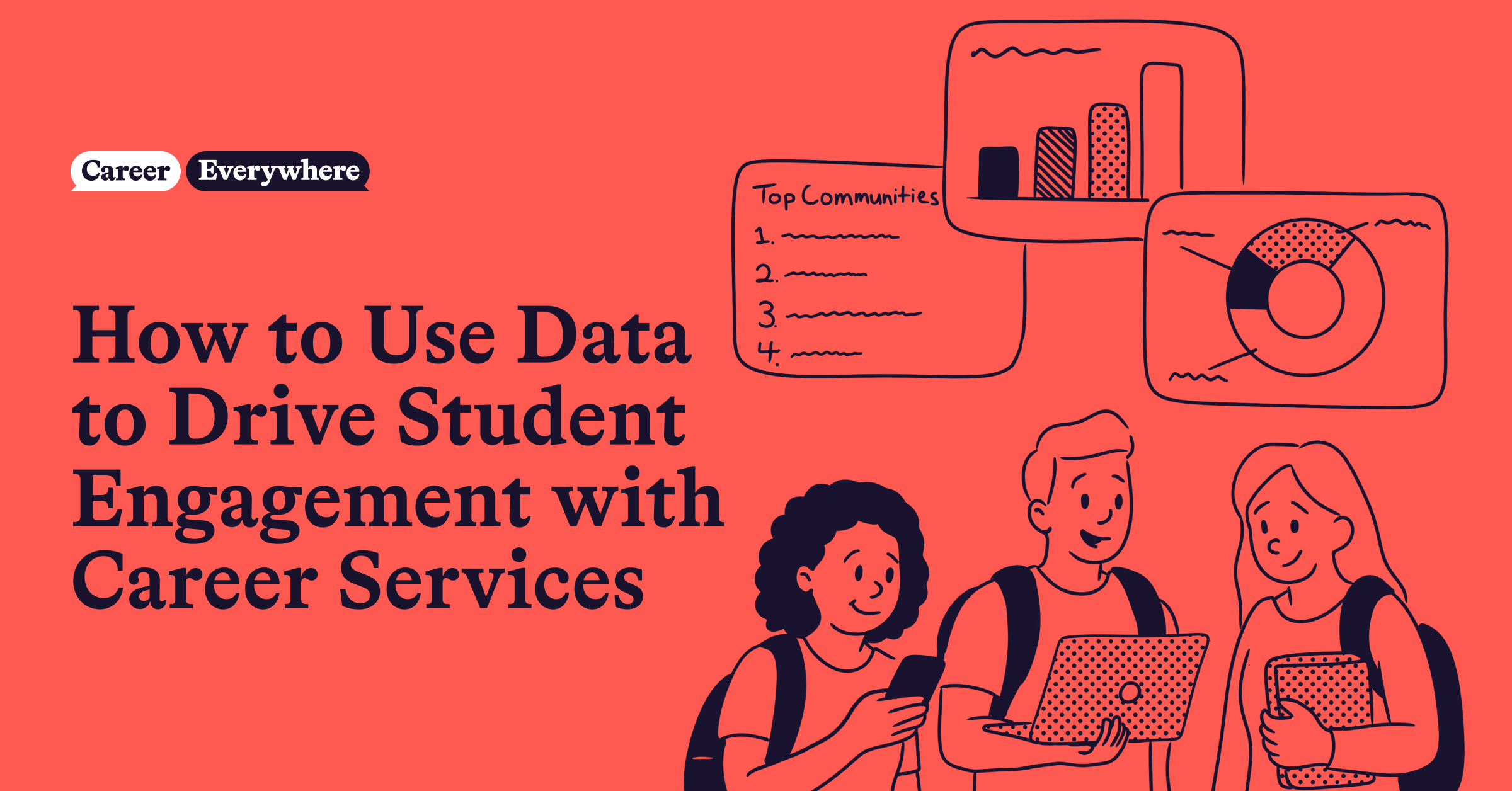
The career services field is at a crossroads.
Over the last several decades, career services has grown and evolved in more ways than I could ever hope to fully capture in this article. Many career leaders, at a wide range of institutions, have made the shift from the more manual, transactional model of the past to the holistic and scalable approach of the present.
And now there’s a growing shift toward the more integrated model of the future, in which (as Christian Garcia and his team at the University of Miami Toppel Career Center say) “Career services is everybody’s business.”
Or as we call it: Career Everywhere.
In short, it’s about pushing career services well beyond the walls of the career center and into the fabric of the campus culture and student experience. It’s about embedding career in classrooms, across campus, and beyond and meeting students where they are, so more students have access to the resources they need to build meaningful careers. It’s about empowering and enabling faculty, staff, executive leaders, alumni, employers, families, and more to engage students in career planning and exploration, making it a much more organic part of the student experience.
In this more integrated model, career services professionals are transitioning from being the sole providers of career services to being both providers and facilitators.
It’s time to make the leap.
Why does career services need to evolve?
Career services has never been more critical (or criticized).
According to the Bureau of Labor Statistics, there are currently about six million people unemployed and nearly 11 million unfilled jobs in the U.S. Plus, Gallup reports that more than 80% of people struggle to find meaning and purpose in their work.
So not only are we seeing challenges with connecting people to jobs, but many who are in jobs are not sufficiently motivated and inspired to do great work. Not to mention, with how quickly our economy is changing, some jobs are disappearing and new jobs are being invented all the time.
We believe the key to helping more people lead fulfilling careers is ensuring more people are engaged in the career planning process, early in their journey, giving them time to learn about pathways and to network and gain experiences, when the stakes aren’t as high as they are later in life.
Most agree that we need to improve access to education and skills. At uConnect, we’d add that it’s critical to improve access to education, skills, and career support.
That’s one of several reasons why we think attacks against career services, particularly the recent “Abolish Career Services” article by Ryan Craig in Forbes, are severely misguided (to put it nicely). Instead of abolishing career services, higher education should be investing more in it.
But I digress.
Students need more career support, earlier, which means career services teams must figure out a way to scale their impact and get everyone on campus involved. Career must become more integrated into the entire student journey, from application to admission to graduation and beyond.
Or as we detail in the section below, career services must move into phase three: Full integration. Fully integrated career services impacts career readiness, recruitment, retention, outcomes, and more. We’re already beginning to see it on several innovative campuses across the country.
Most students enroll in higher education to launch or advance their careers and improve their economic and social mobility. However, many jobs (and companies) no longer require a degree these days, including tech giants like Google. So where does this leave higher education? In my mind, that means it’s time to reinvent the student experience with career support and outcomes as key value drivers.
In order to think about how we do that, let’s look at how career services has evolved over the past 20-plus years.
For more examples of how career services teams are integrating career into the entire student journey, check out the Career Everywhere podcast or subscribe to the Career Everywhere newsletter.
The 3 phases of career services
We’ve come a long way since the career services of the past, and I’m confident this field will continue to grow and evolve in the future. To help us reflect on where we’ve been and where we’re headed, here’s a quick overview of the three major phases of career services. (If you were at the Career Everywhere Roadshow in Boston, this might sound familiar!)
Phase 1: Services and tech (2000-2010)
Back in the 80s and 90s, career services was much more transactional. The career center largely focused on helping students prepare for job applications and interviews through 1:1 resume reviews and mock interviews, supplying a list of potential jobs or internships, etc. (Often faxed by employers, printed out by career services staff, and organized in physical binders. Ah, the good old days.)
Students had to take the initiative to go into a physical career center.
Then as we moved into the early aughts, more career centers began to expand their offering to support students beyond the job search and recruiting process. They expanded advising, evolved their programming, implemented important services like assessments, and encouraged more experiential learning and networking to help students gain exposure and build confidence.
In short, this is when we saw career services start transitioning from a transactional approach to a more holistic approach. Where it’s not just about helping a student get their first job after graduation, it’s about helping them find a career path that’s meaningful to them. It’s about helping them prepare for life.
Phase 2: Scaling (2010-2020)
Phase two saw the implementation of important technologies to reach more students and scale their impact.
More schools started adopting job boards like Handshake, Symplicity, and 12twenty to gain access to thousands of employers and job and internship postings without having to manually source them. Career leaders started to implement mentor platforms like PeopleGrove and Graduway to give students access to large, diverse alumni networks—without career teams having to manually recruit alumni, one at a time.
Career services teams also started using tools like VMock to leverage AI to help scale resume guidance and replace 1:1 manual red-pen resume reviews.
I could probably list dozens of other EdTech tools that came onto the scene in the 2010-2020 era (including uConnect’s virtual career center platform). But in general, this timeframe (aka phase two) was all about leveraging technology to help career services teams scale their impact and reach more students.
Phase 3: Full integration (2020-present)
Career centers all over the country have invested in and implemented many of the EdTech tools mentioned in phase two. But student engagement is still a challenge.
That’s why phase three, the one we’re currently in, is about full integration. It’s about leveraging technology, new strategies, executive leadership, on- and off-campus partnerships, and more to embed career into the overall student experience. It’s about making sure that any faculty, staff, alumni, employers, parents, and other stakeholders are aware of key career resources and prepared (and motivated) to engage students in meaningful career conversations.
In short, phase three is about bringing all campus stakeholders together into one cohesive strategy. Because, as we know, career services teams almost always face daunting student-to-staff ratios, and can’t possibly provide the specialized support their students need to succeed on their own.
But implementing a cohesive strategy is not only about engagement. Engaging students in career planning and exploration, before, during, and after college can have a major impact on enrollment, persistence, outcomes, and even alumni engagement.
For example, consider how much more memorable and impressive a campus tour would be if the tour guide talked about high-profile companies recruiting on campus and shared career success stories of current and former students. Prospective students and families are asking for those insights more than ever, so if an institution isn’t eager to share that information, parents and students will find another that does.
That’s why we’re seeing more top-down directives from presidents about career engagement, or the inclusion of career readiness in strategic plans. It’s why there are more provost-level roles emerging to address campus-wide career readiness.
This shift toward full integration, or what we call Career Everywhere, is indicative of the growing (and frankly, long-overdue) recognition of the importance of career outcomes. And there is no one better to lead the charge than career services.
To learn more about Career Everywhere, check out the Career Everywhere podcast or subscribe to the Career Everywhere newsletter.
Why career services should always own career outcomes
A critical question to ask as more campuses seek to implement more integrated models for career engagement is who will be ultimately responsible for the implementation and success of these initiatives.
We believe career services is perfectly positioned to take the lead.
Radical ideas like Ryan Craig’s proposal to abolish career services and replace it with a faculty-facing function are ill-advised for many reasons. In particular, it’s naive to think that stripping ownership of career outcomes from career services will result in anything other than siloed, inconsistent chaos—and a terrible experience for students.
As one of my colleagues put it, “If career services is everyone’s responsibility, it’s no one’s responsibility.”
Engaging students with career must be owned by someone, and career services has the resources, systems, insights, experience, and connections with employers to manage it better than anyone else.
But they can’t do it all themselves. They’re wildly outnumbered by daunting student-to-advisor ratios, and it’s impossible to imagine how they could equitably support all students from within the walls of the career center.
Therefore, we believe career services should own career outcomes and readiness, but collaborate on those initiatives with on- and off-campus partners to embed career everywhere—from campus tours, to new student orientation, to in-class experiences, to 24/7/365 online resources, to graduation, to alumni support, and more. Those partners could include student organizations, athletics, faculty, employers, alumni mentors, staff, senior leadership, admissions, advancement, academic affairs, etc.
Conclusion
Student engagement is still a top concern for career services leaders, many of whom work closely with us as they implement the uConnect platform. Past phases of career services’ evolution have brought us innovative technology and tools, a shift to a more holistic approach, increased partnerships, and more.
Now it’s time to bring it all together, focus on full integration, and make career readiness a systemic part of the student experience.
To learn how uConnect can help your career center implement Career Everywhere and move into full integration (aka phase three), fill out the form below to schedule a demo.
To learn how uConnect can help you put all of your career resources in one place and make them accessible 24/7, fill out the form below to schedule a demo.


